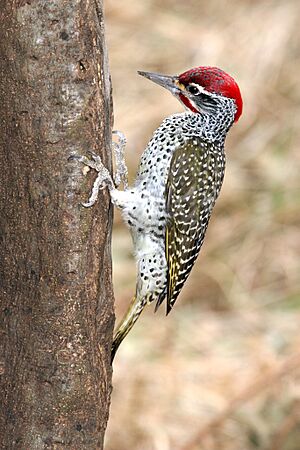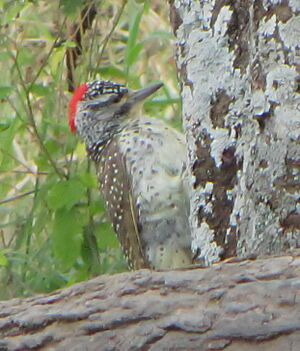Nubian woodpecker facts for kids
Quick facts for kids Nubian woodpecker |
|
|---|---|
 |
|
| Male in Samburu National Reserve, Kenya | |
| Conservation status | |
| Scientific classification | |
| Genus: |
Campethera
|
| Species: |
nubica
|
The Nubian woodpecker (Campethera nubica) is a cool bird that lives in many parts of Central and Eastern Africa. You can find it from countries like Chad all the way to Somalia and down to Tanzania. This woodpecker is quite common and lives in a large area. Its population seems to be doing well. Because of this, a group called the International Union for Conservation of Nature says it's a "least concern" species. This means they are not worried about it becoming endangered anytime soon.
How It Got Its Name
The Nubian woodpecker was first described by a French scientist named Georges-Louis Leclerc, Comte de Buffon in 1780. He wrote about it in his book, Histoire Naturelle des Oiseaux, after seeing a bird from Nubia. An artist named François-Nicolas Martinet also drew a picture of it.
Later, in 1783, a Dutch scientist named Pieter Boddaert gave it its scientific name, Picus nubicus. The bird is now part of a group, or genus, called Campethera. This name was given by an English zoologist, George Robert Gray, in 1841. The name Campethera comes from old Greek words meaning "caterpillar" and "hunter." This tells us a bit about what these birds eat!
There are two main types, or subspecies, of the Nubian woodpecker:
- C. n. nubica (Boddaert, 1783) – This type lives in places like Sudan, Ethiopia, parts of the Democratic Republic of the Congo, southwest Tanzania, and Kenya.
- C. n. pallida (Sharpe, 1902) – This type is found in southern Somalia and along the coast of Kenya.
What It Looks Like
The Nubian woodpecker is a medium-sized bird. It grows to be about 21 centimeters (8 inches) long.
You can tell the male and female apart by their heads. The male has a red cap on its head and a red stripe on its cheek. The female has a black cap with white spots, but her neck is red. She also has a dark stripe on her cheek with white spots.
Both male and female birds have olive-brown upper parts with lots of cream-colored spots and stripes. Their wings are greenish-brown with white stripes. Their tails are greenish-yellow with brown stripes, and the feather shafts are golden. Their throats are cream-colored. Their heads, necks, chests, and bellies are white with black spots and stripes.
Their beaks are grey with a dark tip. Their eyes can be red or pink, and the ring around their eyes is grey. Their feet are olive or grey. These woodpeckers make different sounds. They often make loud, clear, ringing or piping calls. These sounds can be musical or sometimes sound like metal. They often sing these calls together in a duet.
Where It Lives
The Nubian woodpecker lives only in eastern Africa. Its home range includes countries like Chad, Democratic Republic of the Congo, Djibouti, Eritrea, Ethiopia, Kenya, Somalia, South Sudan, Sudan, Tanzania, and Uganda.
It likes to live in open areas with trees, especially those with Acacia and Euphorbia plants. You can also find it in bushy areas and scrubland. This bird does not migrate, meaning it stays in the same area all year round. It can be found at heights up to 2,000 meters (6,600 feet) above sea level.
How It Lives
The Nubian woodpecker often looks for food by itself. However, it stays in touch with its mate by calling out to them. It mostly searches for food in trees, but it also looks on the ground.
Its favorite foods are ants and termites. It also eats spiders and beetles.



